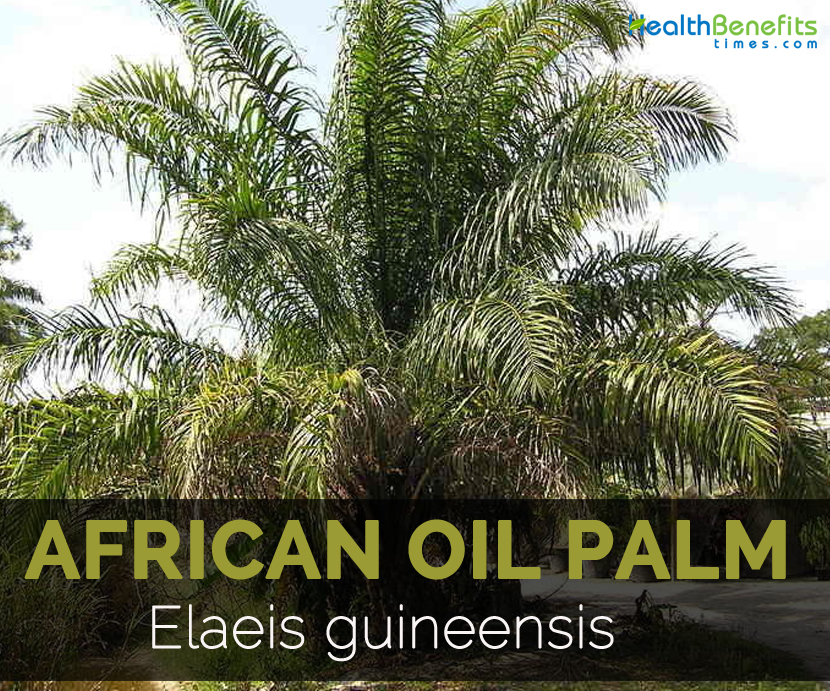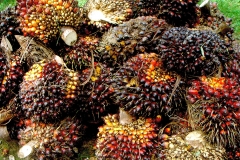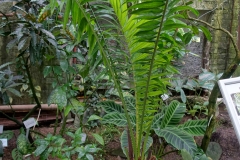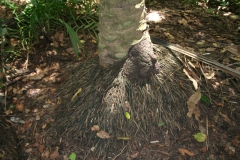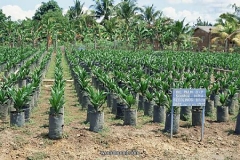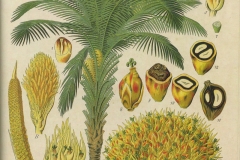Palm oil is obtained from fruits and used for making soaps, candles, cosmetics, biofuels and lubricating greases and in processing tinplate and coating iron plates. It is also used for manufacturing edible products such as ice cream, margarine, cookies, chocolate confections and breads as well as pharmaceuticals.
Plant description
African oil palm is a perennial and armed solitary palm about 8.5 to 30 meters tall, stout, erect and trunks are ringed. Flowers are monoecious; male and female flowers are found in separate clusters. Crown in dark green having skirt of dead leaves. Trunk is 30 cm in diameter. Petioles are saw toothed, fibrous, green, broadened at base, 1.3–2.3 m long and 12.5– 20 cm wide. Leaves have pinnate blade, 3.3-5 m long having 100 to 150 pairs of leaflets in four ranks. Fruit is ovoid to oblong about 3.5 cm long and 2 cm wide that ripen to orange red. Fruit weighs 6 to 20 kg and is made up of outer skin.
- Use the leaf sap for treating skin affections.
- Oil extracted from pulp is emollient and used as excipient for herbal ointments.
- Use it for treating suppurations, swellings of legs and whitlows.
- Yellow leaves are used for treating fever and anemia.
- It can be used to remove thorns and poison from the body.
- Roots are used to treat piles.
- Take the root decoction or burnt root powder orally for treating epilepsy.
- Mix infructesence with burned ginger and apply as enema to young children to promote walking at early age.
- In South Eastern Nigeria, it is used for treating skin infections and various diseases.
Culinary uses
- In Africa, palm wine is obtained by tapping sap from unopened male inflorescences.
- The palm cabbage consists of soft tissues of undeveloped leaves around apical bud which is consumed as vegetables.
- Palm oil is used for making margarine, bakery fats, vegetable ghee, cooking oil and ice cream.
- Unrefined red palm oil is added to soups and sauces in West Africa.
- Use palm oil as frying oil for preparing snacks such as plantain and bean cakes.
References:
https://www.itis.gov/servlet/SingleRpt/SingleRpt?search_topic=TSN&search_value=506719#null
https://pfaf.org/user/Plant.aspx?LatinName=Elaeis+guineensis
http://tropical.theferns.info/viewtropical.php?id=Elaeis+guineensis
https://www.britannica.com/plant/oil-palm
https://uses.plantnet-project.org/en/Elaeis_guineensis_(PROTA)
http://csir-forig.org.gh/tikfom/elaeis-guineensis-0
Comments
comments
| African Oil Palm Quick Facts | |
|---|---|
| Name: | African Oil Palm |
| Scientific Name: | Elaeis guineensis |
| Origin | Tropical rain forest region of West and Central Africa |
| Colors | Green to orange |
| Shapes | Ovoid-oblong, 3.5 cm long, 2 cm wide |
